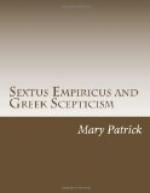[1] Hyp. I. 169.
[2] Hyp. I. 170-171.
[3] Adv. Math. VIII. 185-186; VIII. 56; VII. 369.
[4] Hyp. I. 177.
[5] Hirzel Op. cit. p. 131.
[6] Hyp. I. 3, 7.
[7] Hyp. I. 227.
[8] See Index of Bekker’s edition of Sextus’ works.
We find here in the Sceptical School, shortly after the time of Aenesidemus, the same tendency to dogmatic teaching that—so far as the dim and shadowy history of the last years of the New Academy can be unravelled, and the separation of Pyrrhonism can be understood, at the time that the Academy passed over into eclecticism—was one of the causes of that separation.
It is true that the Tropes of Agrippa show great progress in the development of thought. They furnish an organisation of the School far superior to what went before, placing the reasoning on the firm basis of the laws of logic, and simplifying the amount of material to be used. In a certain sense Saisset is correct in saying that Agrippa contributed more than any other in completing the organisation of Scepticism,[1] but it is not correct when we consider the true spirit of Scepticism with which the Tropes of Agrippa were not in harmony. It was through the very progress shown in the production of these Tropes that the school finally lost the strength of its position.
Not content with having reduced the number of the Tropes from ten to five, others tried to limit the number still further to two.[2] Sextus gives us no hint of the authorship of the two Tropes. Ritter attributes them to Menodotus and his followers, and Zeller agrees with that opinion,[3] while Saisset thinks that Agrippa was also the author of these,[4] which is a strange theory to propound, as some of the material of the five is repeated in the two, and the same man could certainly not appear as an advocate of five, and at the same time of two Tropes.




